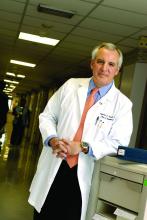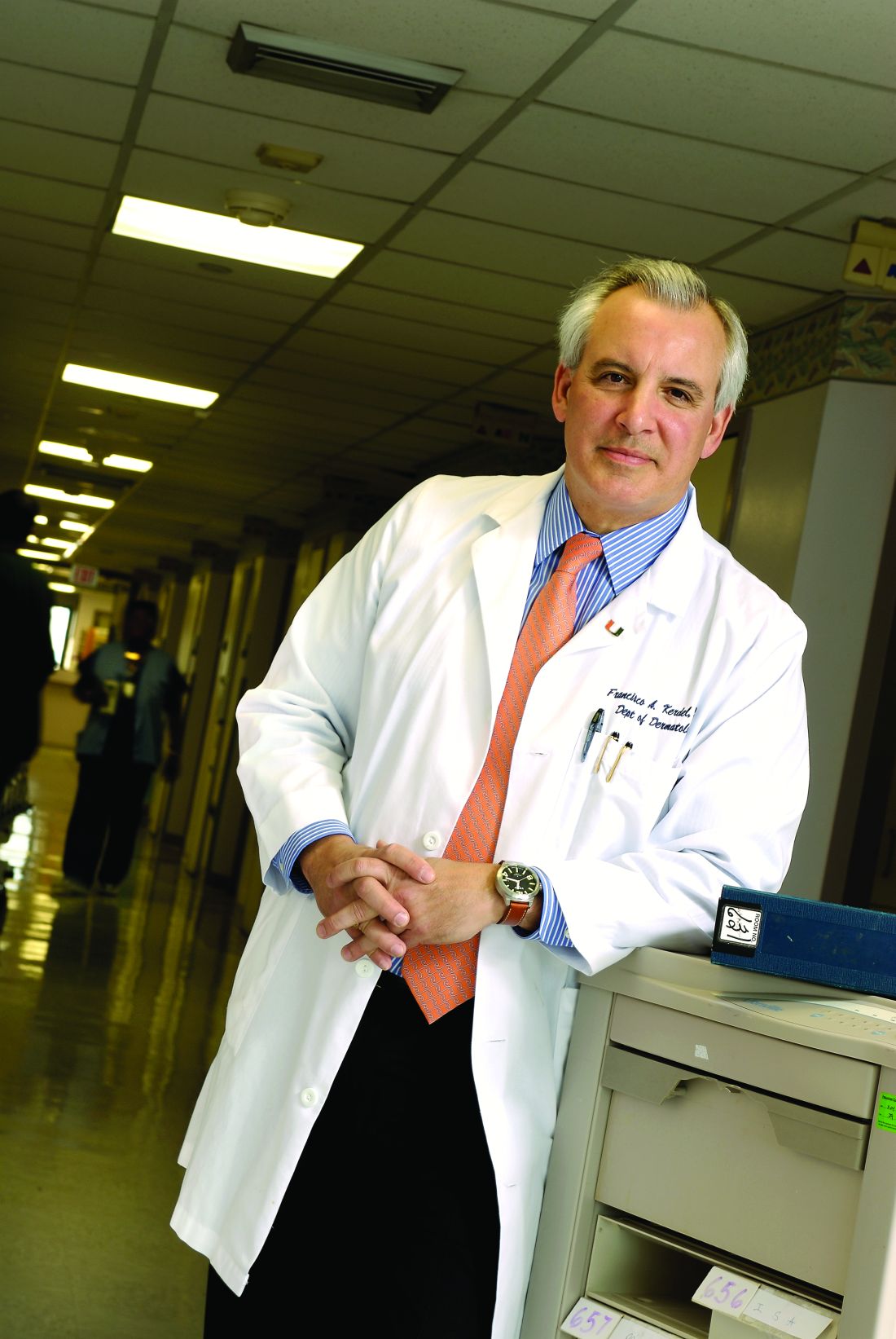User login
Understand form and function to make the most of fillers
LAS VEGAS – Combining the right products and anatomical knowledge translates patient concerns into better outcomes when using fillers, according to Burt Steffes, MD, a dermatologist in Fond du Lac, Wisc.
“If you understand differences in products, you’ll get better results and minimize complications” for different areas, Dr. Steffes said in a presentation at Skin Disease Education Foundation’s annual Las Vegas dermatology seminar.
The physical properties of different fillers impact the results, he pointed out. For example, G prime, a measure of elasticity, varies among fillers; a filler with a higher G prime is more contour stable and is designed to lift tissue, while a product with a lower G prime is designed to spread through tissues and move more naturally with the face.
However, “lift capacity using G prime is only useful across products in the entire family and make up,” Dr. Steffes noted. A recent Allergan-sponsored study emphasized that “product performance is a complex interaction of various properties and tissue interactions not just G prime,” he said (Dermatol Surg, 2015;41:S373-81).
Determining the most effective filler to use depends on the location and area to be corrected.
• Tear troughs: Dr. Steffes recommends avoiding hydrophilic products; he prefers Belotero, Restylane, or Restylane Silk.
• Lips: More flexible products such as Juvederm, Restylane, or Belotero can provide patients with the desired result, he noted.
• Nasolabial fold: Juvederm, Restylane, or Radiesse are appropriate choices likely to produce favorable outcomes, Dr. Steffes said.
• Lateral and midface atrophy: For greater lift and cohesivity in these patients, Dr. Steffes considers Perlane, Voluma, Radiesse, or Sculptra as options.
“Fillers are a great way to help people look and feel better,” but complications occur, so be prepared, he said. “You have to know how to recognize and manage complications.”
Proper management starts with staff education. Provide instruction and training to staff (including reception) on how to recognize impending problems. “Have a written protocol available, and keep nitroglycerin paste, hyaluronidase, and aspirin on hand,” he advised.
Cases of swelling may require hyaluronidase to correct, as may lumps and bumps, Dr. Steffes said. Bruising may be managed with ice packs after the fact, but can often be avoided or minimized by using blunt tip cannulas, slow injections, small aliquots, and small-gauge needles, he added.
In cases of extreme complications such as vascular occlusion, start by massaging the area with nitroglycerin paste, and administer hyaluronidase if necessary, he said. However, be sure to proceed carefully if using hyaluronidase in patients with an allergy to bee stings; use it only in an emergency in these patients and treat anaphylaxis if necessary, he added.
Dr. Steffes had no relevant financial conflicts to disclose.
SDEF and this news organization are owned by the same parent company.
LAS VEGAS – Combining the right products and anatomical knowledge translates patient concerns into better outcomes when using fillers, according to Burt Steffes, MD, a dermatologist in Fond du Lac, Wisc.
“If you understand differences in products, you’ll get better results and minimize complications” for different areas, Dr. Steffes said in a presentation at Skin Disease Education Foundation’s annual Las Vegas dermatology seminar.
The physical properties of different fillers impact the results, he pointed out. For example, G prime, a measure of elasticity, varies among fillers; a filler with a higher G prime is more contour stable and is designed to lift tissue, while a product with a lower G prime is designed to spread through tissues and move more naturally with the face.
However, “lift capacity using G prime is only useful across products in the entire family and make up,” Dr. Steffes noted. A recent Allergan-sponsored study emphasized that “product performance is a complex interaction of various properties and tissue interactions not just G prime,” he said (Dermatol Surg, 2015;41:S373-81).
Determining the most effective filler to use depends on the location and area to be corrected.
• Tear troughs: Dr. Steffes recommends avoiding hydrophilic products; he prefers Belotero, Restylane, or Restylane Silk.
• Lips: More flexible products such as Juvederm, Restylane, or Belotero can provide patients with the desired result, he noted.
• Nasolabial fold: Juvederm, Restylane, or Radiesse are appropriate choices likely to produce favorable outcomes, Dr. Steffes said.
• Lateral and midface atrophy: For greater lift and cohesivity in these patients, Dr. Steffes considers Perlane, Voluma, Radiesse, or Sculptra as options.
“Fillers are a great way to help people look and feel better,” but complications occur, so be prepared, he said. “You have to know how to recognize and manage complications.”
Proper management starts with staff education. Provide instruction and training to staff (including reception) on how to recognize impending problems. “Have a written protocol available, and keep nitroglycerin paste, hyaluronidase, and aspirin on hand,” he advised.
Cases of swelling may require hyaluronidase to correct, as may lumps and bumps, Dr. Steffes said. Bruising may be managed with ice packs after the fact, but can often be avoided or minimized by using blunt tip cannulas, slow injections, small aliquots, and small-gauge needles, he added.
In cases of extreme complications such as vascular occlusion, start by massaging the area with nitroglycerin paste, and administer hyaluronidase if necessary, he said. However, be sure to proceed carefully if using hyaluronidase in patients with an allergy to bee stings; use it only in an emergency in these patients and treat anaphylaxis if necessary, he added.
Dr. Steffes had no relevant financial conflicts to disclose.
SDEF and this news organization are owned by the same parent company.
LAS VEGAS – Combining the right products and anatomical knowledge translates patient concerns into better outcomes when using fillers, according to Burt Steffes, MD, a dermatologist in Fond du Lac, Wisc.
“If you understand differences in products, you’ll get better results and minimize complications” for different areas, Dr. Steffes said in a presentation at Skin Disease Education Foundation’s annual Las Vegas dermatology seminar.
The physical properties of different fillers impact the results, he pointed out. For example, G prime, a measure of elasticity, varies among fillers; a filler with a higher G prime is more contour stable and is designed to lift tissue, while a product with a lower G prime is designed to spread through tissues and move more naturally with the face.
However, “lift capacity using G prime is only useful across products in the entire family and make up,” Dr. Steffes noted. A recent Allergan-sponsored study emphasized that “product performance is a complex interaction of various properties and tissue interactions not just G prime,” he said (Dermatol Surg, 2015;41:S373-81).
Determining the most effective filler to use depends on the location and area to be corrected.
• Tear troughs: Dr. Steffes recommends avoiding hydrophilic products; he prefers Belotero, Restylane, or Restylane Silk.
• Lips: More flexible products such as Juvederm, Restylane, or Belotero can provide patients with the desired result, he noted.
• Nasolabial fold: Juvederm, Restylane, or Radiesse are appropriate choices likely to produce favorable outcomes, Dr. Steffes said.
• Lateral and midface atrophy: For greater lift and cohesivity in these patients, Dr. Steffes considers Perlane, Voluma, Radiesse, or Sculptra as options.
“Fillers are a great way to help people look and feel better,” but complications occur, so be prepared, he said. “You have to know how to recognize and manage complications.”
Proper management starts with staff education. Provide instruction and training to staff (including reception) on how to recognize impending problems. “Have a written protocol available, and keep nitroglycerin paste, hyaluronidase, and aspirin on hand,” he advised.
Cases of swelling may require hyaluronidase to correct, as may lumps and bumps, Dr. Steffes said. Bruising may be managed with ice packs after the fact, but can often be avoided or minimized by using blunt tip cannulas, slow injections, small aliquots, and small-gauge needles, he added.
In cases of extreme complications such as vascular occlusion, start by massaging the area with nitroglycerin paste, and administer hyaluronidase if necessary, he said. However, be sure to proceed carefully if using hyaluronidase in patients with an allergy to bee stings; use it only in an emergency in these patients and treat anaphylaxis if necessary, he added.
Dr. Steffes had no relevant financial conflicts to disclose.
SDEF and this news organization are owned by the same parent company.
EXPERT ANALYSIS FROM SDEF LAS VEGAS DERMATOLOGY SEMINAR
Simple tips optimize toxin treatments
LAS VEGAS – Listening to patients is the “first and most important step” toward using neuromodulators successfully, according to Burt Steffes, MD.
Clinicians armed with a thorough knowledge of anatomy and the available products can use neuromodulators successfully for a range of aging concerns including the glabellar complex, crow’s feet, marionette lines, smoker’s lines, a dimpled chin, and platysmal bands, Dr. Steffes, a dermatologist in Fond du Lac, Wisc., said in a presentation at Skin Disease Education Foundation’s annual Las Vegas dermatology seminar.
When diluting toxins, be consistent for best results, he advised. “Pick a concentration you like and stick with it,” he said. Establishing realistic expectations and taking preprocedure photos are essential for optimizing results, he added.
Dr. Steffes shared the following tips for successful toxin treatments:
• Horizontal forehead rhytids. Check the brow position and stay approximately 2 cm above the eyebrows. Be conservative with the amount of product used to avoid the frozen look. In cases of upper eyelid ptosis, “improvement can be achieved with apraclonidine 0.5% drops,” he said.
• Glabellar complex. Dr. Steffes said he usually uses 10-30 units. Avoid blood vessels to avoid bruising, he said, “and ask patients to scowl” to identify the exact location for injections.
• Crow’s feet. Treatment of crow’s feet means managing an area “of great variability,” Dr. Steffes said. He advised using superficial injections to minimize bruising, while staying 2 cm from the orbital rim and adjusting to match the patient’s rhytid pattern. He recommends 1-2 units placed 1 cm below the lower eyelid margin at the mid-pupillary line to decrease the bunching of the lower eyelid.
• Platysmal bands. Managing volume is the key to successful treatment of platysmal bands, said Dr. Steffes. “Injecting too much product into the neck can lead to asymmetry” he cautioned. Pinch the platysmal band between the fingers and inject intramuscularly, using 2 units per injection. “Use conservative amounts and adjust in two weeks if needed,” he said.
Be sure that all patients make follow-up appointments before they leave the office after a procedure, and schedule new patients for follow-up in 2 weeks, said Dr. Steffes. Instruct all patients to contact your office immediately for any concerns including bruising that may be managed within the first 24-48 hours with a low-fluence 595-nm, 532-nm, or 1,064-nm laser, he added.
Dr. Steffes had no relevant financial conflicts to disclose.
SDEF and this news organization are owned by the same parent company.
LAS VEGAS – Listening to patients is the “first and most important step” toward using neuromodulators successfully, according to Burt Steffes, MD.
Clinicians armed with a thorough knowledge of anatomy and the available products can use neuromodulators successfully for a range of aging concerns including the glabellar complex, crow’s feet, marionette lines, smoker’s lines, a dimpled chin, and platysmal bands, Dr. Steffes, a dermatologist in Fond du Lac, Wisc., said in a presentation at Skin Disease Education Foundation’s annual Las Vegas dermatology seminar.
When diluting toxins, be consistent for best results, he advised. “Pick a concentration you like and stick with it,” he said. Establishing realistic expectations and taking preprocedure photos are essential for optimizing results, he added.
Dr. Steffes shared the following tips for successful toxin treatments:
• Horizontal forehead rhytids. Check the brow position and stay approximately 2 cm above the eyebrows. Be conservative with the amount of product used to avoid the frozen look. In cases of upper eyelid ptosis, “improvement can be achieved with apraclonidine 0.5% drops,” he said.
• Glabellar complex. Dr. Steffes said he usually uses 10-30 units. Avoid blood vessels to avoid bruising, he said, “and ask patients to scowl” to identify the exact location for injections.
• Crow’s feet. Treatment of crow’s feet means managing an area “of great variability,” Dr. Steffes said. He advised using superficial injections to minimize bruising, while staying 2 cm from the orbital rim and adjusting to match the patient’s rhytid pattern. He recommends 1-2 units placed 1 cm below the lower eyelid margin at the mid-pupillary line to decrease the bunching of the lower eyelid.
• Platysmal bands. Managing volume is the key to successful treatment of platysmal bands, said Dr. Steffes. “Injecting too much product into the neck can lead to asymmetry” he cautioned. Pinch the platysmal band between the fingers and inject intramuscularly, using 2 units per injection. “Use conservative amounts and adjust in two weeks if needed,” he said.
Be sure that all patients make follow-up appointments before they leave the office after a procedure, and schedule new patients for follow-up in 2 weeks, said Dr. Steffes. Instruct all patients to contact your office immediately for any concerns including bruising that may be managed within the first 24-48 hours with a low-fluence 595-nm, 532-nm, or 1,064-nm laser, he added.
Dr. Steffes had no relevant financial conflicts to disclose.
SDEF and this news organization are owned by the same parent company.
LAS VEGAS – Listening to patients is the “first and most important step” toward using neuromodulators successfully, according to Burt Steffes, MD.
Clinicians armed with a thorough knowledge of anatomy and the available products can use neuromodulators successfully for a range of aging concerns including the glabellar complex, crow’s feet, marionette lines, smoker’s lines, a dimpled chin, and platysmal bands, Dr. Steffes, a dermatologist in Fond du Lac, Wisc., said in a presentation at Skin Disease Education Foundation’s annual Las Vegas dermatology seminar.
When diluting toxins, be consistent for best results, he advised. “Pick a concentration you like and stick with it,” he said. Establishing realistic expectations and taking preprocedure photos are essential for optimizing results, he added.
Dr. Steffes shared the following tips for successful toxin treatments:
• Horizontal forehead rhytids. Check the brow position and stay approximately 2 cm above the eyebrows. Be conservative with the amount of product used to avoid the frozen look. In cases of upper eyelid ptosis, “improvement can be achieved with apraclonidine 0.5% drops,” he said.
• Glabellar complex. Dr. Steffes said he usually uses 10-30 units. Avoid blood vessels to avoid bruising, he said, “and ask patients to scowl” to identify the exact location for injections.
• Crow’s feet. Treatment of crow’s feet means managing an area “of great variability,” Dr. Steffes said. He advised using superficial injections to minimize bruising, while staying 2 cm from the orbital rim and adjusting to match the patient’s rhytid pattern. He recommends 1-2 units placed 1 cm below the lower eyelid margin at the mid-pupillary line to decrease the bunching of the lower eyelid.
• Platysmal bands. Managing volume is the key to successful treatment of platysmal bands, said Dr. Steffes. “Injecting too much product into the neck can lead to asymmetry” he cautioned. Pinch the platysmal band between the fingers and inject intramuscularly, using 2 units per injection. “Use conservative amounts and adjust in two weeks if needed,” he said.
Be sure that all patients make follow-up appointments before they leave the office after a procedure, and schedule new patients for follow-up in 2 weeks, said Dr. Steffes. Instruct all patients to contact your office immediately for any concerns including bruising that may be managed within the first 24-48 hours with a low-fluence 595-nm, 532-nm, or 1,064-nm laser, he added.
Dr. Steffes had no relevant financial conflicts to disclose.
SDEF and this news organization are owned by the same parent company.
EXPERT ANALYSIS FROM SDEF LAS VEGAS DERMATOLOGY SEMINAR
VIDEO: Tune in to psoriasis patients’ quality of life
LAS VEGAS – Physicians often fail to predict the impact of disease on quality of life in their psoriasis patients, which can help guide treatment, Joel Gelfand, MD, said in a video interview at Skin Disease Education Foundation’s annual Las Vegas dermatology seminar.
“This is true across all medical conditions,” said Dr. Gelfand, professor of dermatology, at the University of Pennsylvania, Philadelphia. For example, some patients with psoriasis may have extensive disease, but it doesn’t bother them, and therefore they may need less treatment, he pointed out.
In his practice, patients with psoriasis are asked to rate physical symptoms (including flaking and itching) and emotional symptoms (including anxiety and depression) related to their disease on a scale of 0 to 10, with 10 being the worst. “The higher those scores are, the more aggressive I’ll be in treating them,” he said. Patient scores can be tracked over time, to review progress with their chosen treatment, he noted.
Dr. Gelfand disclosed relationships with multiple companies including AbbVie, Janssen, Lilly, Novartis, Celgene, Merck, Sanofi, Pfizer, and Valeant.
SDEF and this news organization are owned by the same parent company.
The video associated with this article is no longer available on this site. Please view all of our videos on the MDedge YouTube channel
LAS VEGAS – Physicians often fail to predict the impact of disease on quality of life in their psoriasis patients, which can help guide treatment, Joel Gelfand, MD, said in a video interview at Skin Disease Education Foundation’s annual Las Vegas dermatology seminar.
“This is true across all medical conditions,” said Dr. Gelfand, professor of dermatology, at the University of Pennsylvania, Philadelphia. For example, some patients with psoriasis may have extensive disease, but it doesn’t bother them, and therefore they may need less treatment, he pointed out.
In his practice, patients with psoriasis are asked to rate physical symptoms (including flaking and itching) and emotional symptoms (including anxiety and depression) related to their disease on a scale of 0 to 10, with 10 being the worst. “The higher those scores are, the more aggressive I’ll be in treating them,” he said. Patient scores can be tracked over time, to review progress with their chosen treatment, he noted.
Dr. Gelfand disclosed relationships with multiple companies including AbbVie, Janssen, Lilly, Novartis, Celgene, Merck, Sanofi, Pfizer, and Valeant.
SDEF and this news organization are owned by the same parent company.
The video associated with this article is no longer available on this site. Please view all of our videos on the MDedge YouTube channel
LAS VEGAS – Physicians often fail to predict the impact of disease on quality of life in their psoriasis patients, which can help guide treatment, Joel Gelfand, MD, said in a video interview at Skin Disease Education Foundation’s annual Las Vegas dermatology seminar.
“This is true across all medical conditions,” said Dr. Gelfand, professor of dermatology, at the University of Pennsylvania, Philadelphia. For example, some patients with psoriasis may have extensive disease, but it doesn’t bother them, and therefore they may need less treatment, he pointed out.
In his practice, patients with psoriasis are asked to rate physical symptoms (including flaking and itching) and emotional symptoms (including anxiety and depression) related to their disease on a scale of 0 to 10, with 10 being the worst. “The higher those scores are, the more aggressive I’ll be in treating them,” he said. Patient scores can be tracked over time, to review progress with their chosen treatment, he noted.
Dr. Gelfand disclosed relationships with multiple companies including AbbVie, Janssen, Lilly, Novartis, Celgene, Merck, Sanofi, Pfizer, and Valeant.
SDEF and this news organization are owned by the same parent company.
The video associated with this article is no longer available on this site. Please view all of our videos on the MDedge YouTube channel
At SDEF LAS VEGAS DERMATOLOGY SEMINAR
VIDEO: Challenging case – consider HSV with erythema multiforme
LAS VEGAS – In a presentation at Skin Disease Education Foundation’s annual Las Vegas dermatology seminar, Miriam S. Bettencourt, MD, shared a challenging diagnostic case of erythema multiforme associated with herpes simplex, in a patient who presented with blisters all over his body.
“We know that 90% of cases of erythema multiforme are related to herpetic infections,” but this patient had no recent history of herpes simplex outbreaks, Dr. Bettencourt, of the University of Nevada, Las Vegas, said in a video interview.
‘“Let’s remember that HSV [herpes simplex virus] ... can be associated with erythema multiforme even if a patient does not have any flares,” Dr. Bettencourt said. A consult with a rheumatologist can be helpful, as in this case, if a patient has a positive antinuclear antibody test, which could not be explained, she added, noting that the patient is doing well after 6 months of therapy.
Dr. Bettencourt disclosed relationships with AbbVie, Allergan, Aqua, Celgene, Janssen, IntraDerm, Leo, Promius, and Valeant.
SDEF and this news organization are owned by the same parent company.
The video associated with this article is no longer available on this site. Please view all of our videos on the MDedge YouTube channel
LAS VEGAS – In a presentation at Skin Disease Education Foundation’s annual Las Vegas dermatology seminar, Miriam S. Bettencourt, MD, shared a challenging diagnostic case of erythema multiforme associated with herpes simplex, in a patient who presented with blisters all over his body.
“We know that 90% of cases of erythema multiforme are related to herpetic infections,” but this patient had no recent history of herpes simplex outbreaks, Dr. Bettencourt, of the University of Nevada, Las Vegas, said in a video interview.
‘“Let’s remember that HSV [herpes simplex virus] ... can be associated with erythema multiforme even if a patient does not have any flares,” Dr. Bettencourt said. A consult with a rheumatologist can be helpful, as in this case, if a patient has a positive antinuclear antibody test, which could not be explained, she added, noting that the patient is doing well after 6 months of therapy.
Dr. Bettencourt disclosed relationships with AbbVie, Allergan, Aqua, Celgene, Janssen, IntraDerm, Leo, Promius, and Valeant.
SDEF and this news organization are owned by the same parent company.
The video associated with this article is no longer available on this site. Please view all of our videos on the MDedge YouTube channel
LAS VEGAS – In a presentation at Skin Disease Education Foundation’s annual Las Vegas dermatology seminar, Miriam S. Bettencourt, MD, shared a challenging diagnostic case of erythema multiforme associated with herpes simplex, in a patient who presented with blisters all over his body.
“We know that 90% of cases of erythema multiforme are related to herpetic infections,” but this patient had no recent history of herpes simplex outbreaks, Dr. Bettencourt, of the University of Nevada, Las Vegas, said in a video interview.
‘“Let’s remember that HSV [herpes simplex virus] ... can be associated with erythema multiforme even if a patient does not have any flares,” Dr. Bettencourt said. A consult with a rheumatologist can be helpful, as in this case, if a patient has a positive antinuclear antibody test, which could not be explained, she added, noting that the patient is doing well after 6 months of therapy.
Dr. Bettencourt disclosed relationships with AbbVie, Allergan, Aqua, Celgene, Janssen, IntraDerm, Leo, Promius, and Valeant.
SDEF and this news organization are owned by the same parent company.
The video associated with this article is no longer available on this site. Please view all of our videos on the MDedge YouTube channel
AT SDEF LAS VEGAS DERMATOLOGY SEMINAR
VIDEO: For facial resurfacing, revisit CO2 lasers
LAS VEGAS – Patients can enjoy positive results from facial resurfacing with fractionated lasers, but they don’t always yield the same benefits as the traditional CO2 laser, Christopher Zachary, M.D., said at Skin Disease Education Foundation’s annual Las Vegas dermatology seminar.
“A lot of us are going back to using traditional laser resurfacing” for the patients who need it, such as those with many wrinkles, crepey skin, and extensive sun damage, Dr. Zachary, professor and chair of the department of dermatology at the University of California, Irvine, said in a video interview.
“Those patients are not going to have an optimal result, even with the most aggressive of fractionated ablative lasers, as compared to the traditional laser resurfacing,” he added.
Dr. Zachary disclosed relationships with multiple companies, including Solta, Zeltiq, Scion, Amway, and Candela. SDEF and this news organization are owned by the same parent company.
The video associated with this article is no longer available on this site. Please view all of our videos on the MDedge YouTube channel
LAS VEGAS – Patients can enjoy positive results from facial resurfacing with fractionated lasers, but they don’t always yield the same benefits as the traditional CO2 laser, Christopher Zachary, M.D., said at Skin Disease Education Foundation’s annual Las Vegas dermatology seminar.
“A lot of us are going back to using traditional laser resurfacing” for the patients who need it, such as those with many wrinkles, crepey skin, and extensive sun damage, Dr. Zachary, professor and chair of the department of dermatology at the University of California, Irvine, said in a video interview.
“Those patients are not going to have an optimal result, even with the most aggressive of fractionated ablative lasers, as compared to the traditional laser resurfacing,” he added.
Dr. Zachary disclosed relationships with multiple companies, including Solta, Zeltiq, Scion, Amway, and Candela. SDEF and this news organization are owned by the same parent company.
The video associated with this article is no longer available on this site. Please view all of our videos on the MDedge YouTube channel
LAS VEGAS – Patients can enjoy positive results from facial resurfacing with fractionated lasers, but they don’t always yield the same benefits as the traditional CO2 laser, Christopher Zachary, M.D., said at Skin Disease Education Foundation’s annual Las Vegas dermatology seminar.
“A lot of us are going back to using traditional laser resurfacing” for the patients who need it, such as those with many wrinkles, crepey skin, and extensive sun damage, Dr. Zachary, professor and chair of the department of dermatology at the University of California, Irvine, said in a video interview.
“Those patients are not going to have an optimal result, even with the most aggressive of fractionated ablative lasers, as compared to the traditional laser resurfacing,” he added.
Dr. Zachary disclosed relationships with multiple companies, including Solta, Zeltiq, Scion, Amway, and Candela. SDEF and this news organization are owned by the same parent company.
The video associated with this article is no longer available on this site. Please view all of our videos on the MDedge YouTube channel
AT SDEF LAS VEGAS DERMATOLOGY SEMINAR
VIDEO: Bulk matters in body sculpting
LAS VEGAS – Both heating and cooling techniques can provide effective results for patients seeking to improve their appearance with body sculpting, Christopher Zachary, MD, said at Skin Disease Education Foundation’s annual Las Vegas dermatology seminar.
Whether the clinician chooses devices that use radiofrequency, laser, or cryolipolysis to target fat, the key is bulk treatment, Dr. Zachary, professor and chair of the department of dermatology at the University of California, Irvine, said in a video interview.
When cooling or heating the fat, “it has to been done in bulk; it has to be done for a certain length of time,” he said, noting that treatment times vary with devices, from 5 to 60 minutes. “I can’t stress enough the importance of bulk cooling or bulk heating,” which induce a chronic reaction “that results in localized fat reduction,” he added.
Dr. Zachary disclosed relationships with multiple companies, including Solta, Zeltiq, Scion, Amway, and Candela. SDEF and this news organization are owned by the same parent company.
The video associated with this article is no longer available on this site. Please view all of our videos on the MDedge YouTube channel
LAS VEGAS – Both heating and cooling techniques can provide effective results for patients seeking to improve their appearance with body sculpting, Christopher Zachary, MD, said at Skin Disease Education Foundation’s annual Las Vegas dermatology seminar.
Whether the clinician chooses devices that use radiofrequency, laser, or cryolipolysis to target fat, the key is bulk treatment, Dr. Zachary, professor and chair of the department of dermatology at the University of California, Irvine, said in a video interview.
When cooling or heating the fat, “it has to been done in bulk; it has to be done for a certain length of time,” he said, noting that treatment times vary with devices, from 5 to 60 minutes. “I can’t stress enough the importance of bulk cooling or bulk heating,” which induce a chronic reaction “that results in localized fat reduction,” he added.
Dr. Zachary disclosed relationships with multiple companies, including Solta, Zeltiq, Scion, Amway, and Candela. SDEF and this news organization are owned by the same parent company.
The video associated with this article is no longer available on this site. Please view all of our videos on the MDedge YouTube channel
LAS VEGAS – Both heating and cooling techniques can provide effective results for patients seeking to improve their appearance with body sculpting, Christopher Zachary, MD, said at Skin Disease Education Foundation’s annual Las Vegas dermatology seminar.
Whether the clinician chooses devices that use radiofrequency, laser, or cryolipolysis to target fat, the key is bulk treatment, Dr. Zachary, professor and chair of the department of dermatology at the University of California, Irvine, said in a video interview.
When cooling or heating the fat, “it has to been done in bulk; it has to be done for a certain length of time,” he said, noting that treatment times vary with devices, from 5 to 60 minutes. “I can’t stress enough the importance of bulk cooling or bulk heating,” which induce a chronic reaction “that results in localized fat reduction,” he added.
Dr. Zachary disclosed relationships with multiple companies, including Solta, Zeltiq, Scion, Amway, and Candela. SDEF and this news organization are owned by the same parent company.
The video associated with this article is no longer available on this site. Please view all of our videos on the MDedge YouTube channel
AT SDEF LAS VEGAS DERMATOLOGY SEMINAR
Optimize anti–TNF-alpha therapy for psoriasis
While anti–tumor necrosis factor (TNF)-alpha medications have shown effectiveness for psoriasis, ongoing issues include optimizing therapy, managing treatment in special populations, and comparing the drugs with newer therapies, according to Dr. Francisco A. Kerdel.
Among the concerns regarding optimizing anti–TNF-alpha therapy are loss of response, continuous versus intermittent dosing, combination therapy, and long-term safety and efficacy, Dr. Kerdel, professor and vice-chair of the department of dermatology, Florida International University, Miami, said in a presentation at the Skin Disease Education Foundation’s annual Las Vegas Dermatology Seminar.
However, “no evidence-based guidelines are available for screening and monitoring patients receiving biologic therapy for psoriasis,” Dr. Kerdel noted.
Patient factors that impact the choice and potential response of anti–TNF-alpha therapy include not only physical issues such as weight, disease activity, and comorbidities, but also patient preferences for simpler dosing regimens or a desire to avoid injections, he said.
Despite these issues, there is currently no consensus on and no guidelines for switching treatments after failure with an anti–TNF-alpha agent, he noted.
Other questions associated with anti–TNF-alpha agents in psoriasis include whether the loading dose recommended by most drug labels is necessary, according to Dr. Kerdel. “In practice, many clinicians omit the loading dosage and initiate therapy with maintenance doses,” he said. In addition, “physicians should use clinical judgment when screening and monitoring patients taking biologic agents.”
From a dermatologist perspective, the top unmet therapeutic needs in the treatment of psoriasis were improved efficacy, improved tolerability, improved long-term safety, another oral treatment option, and a new mechanism of action, based on a survey that included 391 dermatologists (J Eur Acad Dermatol Venereol. 2015 Oct;29[10]:2002-10).
As psoriasis treatments evolve, other issues include compiling real-world, postmarketing data on biosimilars; monitoring patients for the emergence of significant adverse events; and searching for biomarkers to help target biologics to specific patients and psoriasis subtypes, Dr. Kerdel added.
SDEF and this news organization are owned by the same parent company.
Dr. Kerdel disclosed being a speaker for AbbVie, Amgen, Celgene, Galderma, and Janssen; conducting research for those 5 companies and for Novartis, Pfizer, and Valeant; he is also on the board of Celgene.
While anti–tumor necrosis factor (TNF)-alpha medications have shown effectiveness for psoriasis, ongoing issues include optimizing therapy, managing treatment in special populations, and comparing the drugs with newer therapies, according to Dr. Francisco A. Kerdel.
Among the concerns regarding optimizing anti–TNF-alpha therapy are loss of response, continuous versus intermittent dosing, combination therapy, and long-term safety and efficacy, Dr. Kerdel, professor and vice-chair of the department of dermatology, Florida International University, Miami, said in a presentation at the Skin Disease Education Foundation’s annual Las Vegas Dermatology Seminar.
However, “no evidence-based guidelines are available for screening and monitoring patients receiving biologic therapy for psoriasis,” Dr. Kerdel noted.
Patient factors that impact the choice and potential response of anti–TNF-alpha therapy include not only physical issues such as weight, disease activity, and comorbidities, but also patient preferences for simpler dosing regimens or a desire to avoid injections, he said.
Despite these issues, there is currently no consensus on and no guidelines for switching treatments after failure with an anti–TNF-alpha agent, he noted.
Other questions associated with anti–TNF-alpha agents in psoriasis include whether the loading dose recommended by most drug labels is necessary, according to Dr. Kerdel. “In practice, many clinicians omit the loading dosage and initiate therapy with maintenance doses,” he said. In addition, “physicians should use clinical judgment when screening and monitoring patients taking biologic agents.”
From a dermatologist perspective, the top unmet therapeutic needs in the treatment of psoriasis were improved efficacy, improved tolerability, improved long-term safety, another oral treatment option, and a new mechanism of action, based on a survey that included 391 dermatologists (J Eur Acad Dermatol Venereol. 2015 Oct;29[10]:2002-10).
As psoriasis treatments evolve, other issues include compiling real-world, postmarketing data on biosimilars; monitoring patients for the emergence of significant adverse events; and searching for biomarkers to help target biologics to specific patients and psoriasis subtypes, Dr. Kerdel added.
SDEF and this news organization are owned by the same parent company.
Dr. Kerdel disclosed being a speaker for AbbVie, Amgen, Celgene, Galderma, and Janssen; conducting research for those 5 companies and for Novartis, Pfizer, and Valeant; he is also on the board of Celgene.
While anti–tumor necrosis factor (TNF)-alpha medications have shown effectiveness for psoriasis, ongoing issues include optimizing therapy, managing treatment in special populations, and comparing the drugs with newer therapies, according to Dr. Francisco A. Kerdel.
Among the concerns regarding optimizing anti–TNF-alpha therapy are loss of response, continuous versus intermittent dosing, combination therapy, and long-term safety and efficacy, Dr. Kerdel, professor and vice-chair of the department of dermatology, Florida International University, Miami, said in a presentation at the Skin Disease Education Foundation’s annual Las Vegas Dermatology Seminar.
However, “no evidence-based guidelines are available for screening and monitoring patients receiving biologic therapy for psoriasis,” Dr. Kerdel noted.
Patient factors that impact the choice and potential response of anti–TNF-alpha therapy include not only physical issues such as weight, disease activity, and comorbidities, but also patient preferences for simpler dosing regimens or a desire to avoid injections, he said.
Despite these issues, there is currently no consensus on and no guidelines for switching treatments after failure with an anti–TNF-alpha agent, he noted.
Other questions associated with anti–TNF-alpha agents in psoriasis include whether the loading dose recommended by most drug labels is necessary, according to Dr. Kerdel. “In practice, many clinicians omit the loading dosage and initiate therapy with maintenance doses,” he said. In addition, “physicians should use clinical judgment when screening and monitoring patients taking biologic agents.”
From a dermatologist perspective, the top unmet therapeutic needs in the treatment of psoriasis were improved efficacy, improved tolerability, improved long-term safety, another oral treatment option, and a new mechanism of action, based on a survey that included 391 dermatologists (J Eur Acad Dermatol Venereol. 2015 Oct;29[10]:2002-10).
As psoriasis treatments evolve, other issues include compiling real-world, postmarketing data on biosimilars; monitoring patients for the emergence of significant adverse events; and searching for biomarkers to help target biologics to specific patients and psoriasis subtypes, Dr. Kerdel added.
SDEF and this news organization are owned by the same parent company.
Dr. Kerdel disclosed being a speaker for AbbVie, Amgen, Celgene, Galderma, and Janssen; conducting research for those 5 companies and for Novartis, Pfizer, and Valeant; he is also on the board of Celgene.
EXPERT ANALYSIS FROM SDEF LAS VEGAS DERMATOLOGY SEMINAR
VIDEO: IL-23 inhibitors on the upswing
LAS VEGAS – Interleukin-23 (IL-23) inhibitors, currently in the pipeline for treating psoriasis, are showing great promise for the treatment of the disease, Bruce E. Strober, MD, PhD, said in a video interview at the Skin Disease Education Foundation’s Las Vegas Dermatology Seminar.
“There likely will be at least three, if not four, IL-23 inhibitors, all biologics, approved within the next 5 years,” said Dr. Strober, professor and chair of the department of dermatology at the University of Connecticut Health Center, Farmington. “The IL-23 inhibitors are specific, and they seem to be delivering as good or better efficacy than ustekinumab,” with the potential for longer dosing intervals, depending on the patient, he noted.
Dr. Strober disclosed relationships with multiple companies including AbbVie, Amgen, Boehringer Ingelheim, Celgene, Dermira, GlaxoSmithKline, Merck, Novartis, and Pfizer.
SDEF and this news organization are owned by the same parent company.
The video associated with this article is no longer available on this site. Please view all of our videos on the MDedge YouTube channel
LAS VEGAS – Interleukin-23 (IL-23) inhibitors, currently in the pipeline for treating psoriasis, are showing great promise for the treatment of the disease, Bruce E. Strober, MD, PhD, said in a video interview at the Skin Disease Education Foundation’s Las Vegas Dermatology Seminar.
“There likely will be at least three, if not four, IL-23 inhibitors, all biologics, approved within the next 5 years,” said Dr. Strober, professor and chair of the department of dermatology at the University of Connecticut Health Center, Farmington. “The IL-23 inhibitors are specific, and they seem to be delivering as good or better efficacy than ustekinumab,” with the potential for longer dosing intervals, depending on the patient, he noted.
Dr. Strober disclosed relationships with multiple companies including AbbVie, Amgen, Boehringer Ingelheim, Celgene, Dermira, GlaxoSmithKline, Merck, Novartis, and Pfizer.
SDEF and this news organization are owned by the same parent company.
The video associated with this article is no longer available on this site. Please view all of our videos on the MDedge YouTube channel
LAS VEGAS – Interleukin-23 (IL-23) inhibitors, currently in the pipeline for treating psoriasis, are showing great promise for the treatment of the disease, Bruce E. Strober, MD, PhD, said in a video interview at the Skin Disease Education Foundation’s Las Vegas Dermatology Seminar.
“There likely will be at least three, if not four, IL-23 inhibitors, all biologics, approved within the next 5 years,” said Dr. Strober, professor and chair of the department of dermatology at the University of Connecticut Health Center, Farmington. “The IL-23 inhibitors are specific, and they seem to be delivering as good or better efficacy than ustekinumab,” with the potential for longer dosing intervals, depending on the patient, he noted.
Dr. Strober disclosed relationships with multiple companies including AbbVie, Amgen, Boehringer Ingelheim, Celgene, Dermira, GlaxoSmithKline, Merck, Novartis, and Pfizer.
SDEF and this news organization are owned by the same parent company.
The video associated with this article is no longer available on this site. Please view all of our videos on the MDedge YouTube channel
EXPERT ANALYSIS FROM SDEF LAS VEGAS DERMATOLOGY SEMINAR
Biologic-naive psoriasis patients get biggest boost with treatment
LAS VEGAS – Biologic-naive psoriasis patients had stronger responses to treatment than those who were previously treated and switched from one biologic to another, according to a systematic review of 15 studies in adults with psoriasis.
In a real-world setting, patients who fail treatment with a tumor necrosis factor–alfa (TNF-alfa) inhibitor or ustekinumab may be switched from one treatment to another, Steven R. Feldman, MD, professor of dermatology at Wake Forest University, Winston-Salem, N.C., said in a poster presented at the Skin Disease Education Foundation’s annual Las Vegas Dermatology Seminar. “However, there is conflicting evidence of reduced effectiveness in later lines of treatment,” he added.
In four of the studies, biologic-naive patients showed significantly better responses when given anti-TNF agents than patients who had been treated with a biologic. Another study showed that the reduced effectiveness of adalimumab treatment was associated with the number of previous treatments with anti-TNFs (hazard ratio, 1.63). Another study found an association between previous treatment with etanercept and loss of response and serious adverse effects (HR, 4.32).
The other nine studies suggested some evidence of effectiveness for treatment with anti-TNFs or ustekinumab as later lines of treatment for psoriasis patients, but most of the studies (six of nine) did not include information on whether the results were statistically significant.
“More real-world evidence and future research in studies with large sample sizes are needed to further understand the role of anti-TNF and ustekinumab as later-line treatment in psoriasis management,” Dr. Feldman said.
He disclosed relationships with multiple companies, including study sponsor Novartis; one of the study coauthors is affiliated with Novartis. SDEF and this organization are owned by the same parent company.
LAS VEGAS – Biologic-naive psoriasis patients had stronger responses to treatment than those who were previously treated and switched from one biologic to another, according to a systematic review of 15 studies in adults with psoriasis.
In a real-world setting, patients who fail treatment with a tumor necrosis factor–alfa (TNF-alfa) inhibitor or ustekinumab may be switched from one treatment to another, Steven R. Feldman, MD, professor of dermatology at Wake Forest University, Winston-Salem, N.C., said in a poster presented at the Skin Disease Education Foundation’s annual Las Vegas Dermatology Seminar. “However, there is conflicting evidence of reduced effectiveness in later lines of treatment,” he added.
In four of the studies, biologic-naive patients showed significantly better responses when given anti-TNF agents than patients who had been treated with a biologic. Another study showed that the reduced effectiveness of adalimumab treatment was associated with the number of previous treatments with anti-TNFs (hazard ratio, 1.63). Another study found an association between previous treatment with etanercept and loss of response and serious adverse effects (HR, 4.32).
The other nine studies suggested some evidence of effectiveness for treatment with anti-TNFs or ustekinumab as later lines of treatment for psoriasis patients, but most of the studies (six of nine) did not include information on whether the results were statistically significant.
“More real-world evidence and future research in studies with large sample sizes are needed to further understand the role of anti-TNF and ustekinumab as later-line treatment in psoriasis management,” Dr. Feldman said.
He disclosed relationships with multiple companies, including study sponsor Novartis; one of the study coauthors is affiliated with Novartis. SDEF and this organization are owned by the same parent company.
LAS VEGAS – Biologic-naive psoriasis patients had stronger responses to treatment than those who were previously treated and switched from one biologic to another, according to a systematic review of 15 studies in adults with psoriasis.
In a real-world setting, patients who fail treatment with a tumor necrosis factor–alfa (TNF-alfa) inhibitor or ustekinumab may be switched from one treatment to another, Steven R. Feldman, MD, professor of dermatology at Wake Forest University, Winston-Salem, N.C., said in a poster presented at the Skin Disease Education Foundation’s annual Las Vegas Dermatology Seminar. “However, there is conflicting evidence of reduced effectiveness in later lines of treatment,” he added.
In four of the studies, biologic-naive patients showed significantly better responses when given anti-TNF agents than patients who had been treated with a biologic. Another study showed that the reduced effectiveness of adalimumab treatment was associated with the number of previous treatments with anti-TNFs (hazard ratio, 1.63). Another study found an association between previous treatment with etanercept and loss of response and serious adverse effects (HR, 4.32).
The other nine studies suggested some evidence of effectiveness for treatment with anti-TNFs or ustekinumab as later lines of treatment for psoriasis patients, but most of the studies (six of nine) did not include information on whether the results were statistically significant.
“More real-world evidence and future research in studies with large sample sizes are needed to further understand the role of anti-TNF and ustekinumab as later-line treatment in psoriasis management,” Dr. Feldman said.
He disclosed relationships with multiple companies, including study sponsor Novartis; one of the study coauthors is affiliated with Novartis. SDEF and this organization are owned by the same parent company.
AT SDEF LAS VEGAS DERMATOLOGY SEMINAR
Key clinical point:
Major finding: Biologic-naive psoriasis patients had stronger responses to treatment than those who were previously treated and switched from one biologic to another.
Data source: A systematic review of 15 observational studies of adults with psoriasis evaluating anti-TNF agents or ustekinumab as second-line or later-line treatments.
Disclosures: Dr. Feldman disclosed relationships with multiple companies, including study sponsor Novartis; one of the study coauthors is affiliated with Novartis.
VIDEO: Recognizing the systemic impact of rosacea
LAS VEGAS – At its core, “we understand that rosacea is an inflammatory disease,” Linda Stein Gold, MD, said at the Skin Disease Education Foundation’s annual Las Vegas Dermatology Seminar.
As with psoriasis, she added, “we understand that rosacea might have some systemic implications.”
In fact, data suggest that cardiovascular disease is independently associated with rosacea after controlling for multiple variables, she noted. “So we now believe it’s important to get the inflammation under control, not just for the skin, but for the body as a whole,” Dr. Stein Gold, director of dermatology research, Henry Ford Health System, Detroit, said in a video interview.
She disclosed receiving research support, serving as a consultant, serving on the speakers bureau, and/or serving on the scientific advisory board for multiple pharmaceutical companies.
SDEF and this organization are owned by the same parent company.
The video associated with this article is no longer available on this site. Please view all of our videos on the MDedge YouTube channel
LAS VEGAS – At its core, “we understand that rosacea is an inflammatory disease,” Linda Stein Gold, MD, said at the Skin Disease Education Foundation’s annual Las Vegas Dermatology Seminar.
As with psoriasis, she added, “we understand that rosacea might have some systemic implications.”
In fact, data suggest that cardiovascular disease is independently associated with rosacea after controlling for multiple variables, she noted. “So we now believe it’s important to get the inflammation under control, not just for the skin, but for the body as a whole,” Dr. Stein Gold, director of dermatology research, Henry Ford Health System, Detroit, said in a video interview.
She disclosed receiving research support, serving as a consultant, serving on the speakers bureau, and/or serving on the scientific advisory board for multiple pharmaceutical companies.
SDEF and this organization are owned by the same parent company.
The video associated with this article is no longer available on this site. Please view all of our videos on the MDedge YouTube channel
LAS VEGAS – At its core, “we understand that rosacea is an inflammatory disease,” Linda Stein Gold, MD, said at the Skin Disease Education Foundation’s annual Las Vegas Dermatology Seminar.
As with psoriasis, she added, “we understand that rosacea might have some systemic implications.”
In fact, data suggest that cardiovascular disease is independently associated with rosacea after controlling for multiple variables, she noted. “So we now believe it’s important to get the inflammation under control, not just for the skin, but for the body as a whole,” Dr. Stein Gold, director of dermatology research, Henry Ford Health System, Detroit, said in a video interview.
She disclosed receiving research support, serving as a consultant, serving on the speakers bureau, and/or serving on the scientific advisory board for multiple pharmaceutical companies.
SDEF and this organization are owned by the same parent company.
The video associated with this article is no longer available on this site. Please view all of our videos on the MDedge YouTube channel
EXPERT ANALYSIS AT SDEF LAS VEGAS DERMATOLOGY SEMINAR









